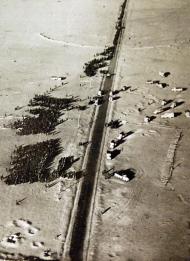Libya, Bardia, Bardia, 6 January 1942
Bardia, Cyrenaica, Libya. 6 January 1942. Aerial view taken on the day that Bardia fell shows a long line of prisoners stretching down the road being rounded up by the Allied land forces and transported in the back of trucks.
Bardia or Bardi is a natural rocky Mediterranean port in Libya, in the far east of the country, east of Tobruk and north of Amsaid, near the Libyan-Egyptian border. It is distinguished by its natural harbor or bay, as well as its status as a key site during World War II in North Africa.
The area was formerly known by names such as "Port of Patrachus" and "Port of Greater Petras."
During World War II, it was a major Italian fort under the command of General Annibale Bigonzoli. On June 21, 1941, the village was bombarded by a squadron of British Mediterranean Fleet cruisers, including HMAS Sydney. The town was captured by Commonwealth forces in Operation Compass, largely composed of the 6th Australian Battalion, in fighting that lasted from January 3 to 5, 1941.
The Axis forces recaptured the village, and it was recaptured by the Allies on January 2, 1942, by infantry from the South African Regiment and New Zealand Cavalry units.
Hundreds of the South Africans, many of whom were poorly trained and equipped, were killed, but approximately 8,000 Allied prisoners were freed and approximately 6,000 Axis prisoners were captured.
There is also a distinctive mural painted during World War II, known as the Papyrus Mural, which is a tourist attraction.
Similar Photos
Admin
696 Photos
-
187
-
0
-
0
License and Use
Free for commercial use Attribution required- Details
- Year Taken 1842
- Country Libyan Arab Jamahiriya
- Photo #552
- Published on Aug 11, 2025
- Photo type JPG
- Resolution 1992x2741
- Photographer unknown
- Category Historical events
- Subcategory Battles & wars
- File size 548.9kB







